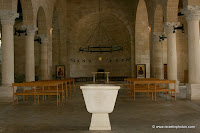The first church on the traditional site was built in the fourth century. A landslide from the nearby hill damaged it, and over its ruins another church was built in the sixth century. The present church, dedicated in 1982, is reproduction of the mid-C5 edifice, which an inscription attributes to the patriarch Martyrios (478-486).
One of the most beautiful mosaic floors in the country belong to the Byzantine church. The mosaics cover the two transepts and the intervals between the pillars. The pattern is a free flowing Tabghadesign of birds and plants. The prominence of the lotus flower (not found in this area) betrays the influence of the Nilotic landscapes popular in Hellenistic and Roman art.
The round tower in the right transept is to measure the water level in the lake; the Greek letters are the numbers 6 to 10. Near the altar the mosaic floor depicts a breadbasket flanked by two fish. Below the altar table is a block of undressed limestone, it is said to be the rock on which Jesus put the loaves and fish. The church belongs to the Order of the Benedictines and is open to visitors.





